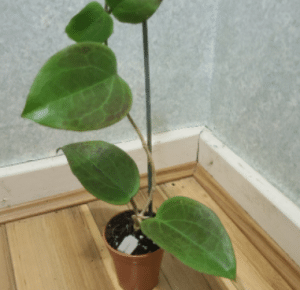Hoya Surigaonesis is a Hoya species that is known for its dark green leaves with rippled white veins. It grows on trees in the Philippines, so it needs to be placed in an area of moderate to high light, but also some protection from direct sunlight.
Hoya Surigaonesis will produce small flowers which are normally white in color.
About Hoya Plants

Hoya plants are native to Asia, Australia, and some Pacific Islands. They grow in a vine-like fashion, so it is recommended that Hoya plants are tied to a trellis or stake of some sort. These plants have thick waxy leaves that allow them to store water.
Hoya plants produce large star-shaped flowers with many petals. Hoya plants are normally white in color, but Hoya plants also produce delicate flowers of pink, purple and red. Hoya plants are very easy to take care of and will even grow indoors! Hoya plants need bright light to full sun , so it’s best to place them near a window that gets direct sunlight.
What’s Special About the Hoya Surigaonesis
The Hoya Surigaonesis has the distinction of being the only Hoya in the Philippines that is considered Royal Hoya by Hoya collectors due to its rarity. Hoya Surigaonesis is a beautiful but rare plant.
Hoya Surigaonesis has many similar Hoya characteristics to Hoya carnosa except Hoya Surigaonesis is more of a lowland plant than most Hoya varieties which are generally mid-level plants.
Caring for The Hoya Surigaonesis
Here are the best practices when caring for a Hoya plant:
Watering
Hoya Surigaonesis plants like slightly moist soil, but not soaked and it’s also a good idea to make sure that your plant is watered well around the roots of the plant.
Lighting Fast Facts
The Hoya Surigaonesis is best suited for growing in areas where it gets bright light to direct sunlight.
These plants can be grown indoors or in greenhouses where the Hoya Surigaonesis can get lots of direct sunlight.
Temperature
The average night time temperature should be around 65 degrees Fahrenheit (18 degrees Celsius), while the average daytime temperature should be around 80 degrees Fahrenheit (26 degrees Celsius).
Humidity Requirements
The humidity requirements for the Hoya Surigaonesis are average. If you can maintain an indoor humidity level around 40% then that would be perfect, but it’s not required that the humidity levels stay at 40%. Just make sure you don’t let your Hoya get too dry.
These are the best practices when caring for your Hoya Surigaonesis plant! If you don’t follow these guidelines, then there is a chance that your plant will get sick or die.
Soil Requirements
The soil requirements for your Hoya Surigaonesis are very simple. All you need to do is make sure the soil drains well and you also want to make sure that the soil has some organic material in it. It’s best to go with a medium to coarse potting soil when caring for your Hoya Surigaonesis plant.
Repotting Requirements for Hoya Surigaonesis
It’s a good idea to repot your Hoya every year, but you don’t have to if you don’t want to. If you do decide that it is a good time for repotting then make sure that you only repot your Hoya Surigaonesis plant in the springtime or early summer.
Propagating Hoya Surigaonesis
It’s very easy to propagate a Hoya Surigaonesis plant by taking cuttings of it and rooting those cuttings. If you want to take your own cuttings then make sure that you’re using a sharp, sterilized knife and then you want to cut the stem of your Hoya Surigaonesis at an angle.
It’s best to dip the end of your Hoya Surigaonesis cutting in some hormone rooting powder or gel before you put it into some moistened perlite and vermiculite. Keep your cutting moist and in a warm location, but not too hot because the heat can kill your newly forming plant.
Conclusion
Hoya Surigaonesis plants are very easy to take care of compared to most houseplants that require some maintenance every week or so.
The Hoya Surigaonesis is a beautiful Hoya that produces stunning flowers. Hopefully, this article has provided useful information about the care of your Hoya, so if you follow these guidelines then there’s no reason why your plant won’t look great!
Related Article: Hoya Kerri Growth and Care Guide
